Sphinginae subfamily
Sphingini tribe:
 |
Ceratomia amyntor
WO,
Elm Sphinx; Four-horned Sphinx:
Forewing upperside brown with dark brown and white markings including white costal area near wing base,
dark streaks along veins, and a white spot in cell. The upperside of the hindwing is light brown and has a dark brown band along the outer margin.
Elm (Ulmus), birch (Betula), basswood (Tilia), and cherry (Prunus). |
 |
Ceratomia undulosa
JFR/WO,
Waved Sphinx:
The upperside of the forewing is pale brownish gray with wavy black and white lines and a black-outlined white cell spot.
The upperside of the hindwing is gray with diffuse darker bands. |
Ceratomia undulosa, July 21, 2006, Joan F. Rickert
Ceratomia undulosa, Medford, June 4, 2011, courtesy of Joan F. Rickert
Ceratomia undulosa, Medford, June 30, 2011, June 3, 2014, Joan F. Rickert
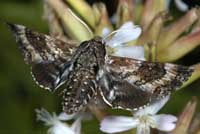 |
Dolba hyloeus
WO, the Pawpaw Sphinx
The upperside of the forewing is dark brown with a dusting of white scales. Some moths have patches of reddish or yellowish
brown on the wings.
Larve are not limited to pawpaw. unlikely, northern limit in WI.
|
 |
The upperside of the forewing is gray with heavy black bands. The upperside of the hindwing is brownish gray with no markings.
The underside is rather plain.
|
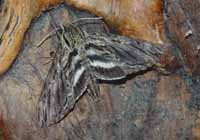 |
Lintneria eremitus JR,
Hermit Sphinx: Fw upperside gray-brown with wavy lines, black dashes, and one or two small white spots near
center of costa. Hw upperside is black with two white bands and triangular black patch at base. Note golden hair on thorax.
Beebalm (Monarda), mints (Mentha), bugleweed (Lycopis), and sage (Salvia).
|
Sphinx eremitus larva find (immature, feeding on Monarda), August 8, 2006, courtesy of Joan F. Rickert.
 |
This large bodied moth flies in tobacco fields and vegetable gardens
(potatoes, tomatoes) and wherever host plants are found.
|
Sphinx canadensis, Medford, June 4, 2011, courtesy of Joan F. Rickert
 |
Sphinx chersis
JFR/WO, Northern Ash Sphinx; Great Ash Sphinx:
The upperside of the forewing is soft dark gray to blue-gray
with a series of black dashes, one of which reaches the wing tip.
|
Sphinx chersis, Medford, July 23, 2011, Joan F. Rickert.
 |
Sphinx drupiferarum
WO, the
Wild Cherry Sphinx:
The costal area in the basal and median areas of the forewing is light grey. This colour also
appears in the terminal area. The rest of the wing is dark slatey grey.
|
 |
Sphinx gordius WO, Apple Sphinx:
Colouration, markings highly variable. Fw fringes mostly black with some white; those on hw mostly white with few black patches.
Fw upperside ranges from brown with black borders through brownish gray with paler borders to pale gray with no borders.
Dashes, submarginal line, cell spot usually weak.
|
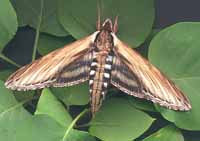 |
The lower forewings are predominantly brownish-yellow with a fairly wide dark bar along the inner margin. At rest the
wings hug the body, giving the moth a long slender look.
|
Sphinx kalmiae, July 28, 2006, Joan F. Rickert
 |
Sphinx luscitiosa
WO, Canadian Sphinx, Clemen's Sphinx:
Fw yellowish gray in males; pale gray with faint yellow tint in females.
Dark border on outer margin widens as it approaches inner margin.
Hw deep yellow in males, pale yellow in females; both with wide black border.
|
 |
Sphinx poecila WO, Poecila Sphinx:
If you have blueberries in the woods, then you probably have the
Poecila Sphinx. They are probably widespread throughout Wisconsin,
but are very much under reported.
|
 |
Sphinx vashti WO, Snowberry Sphinx:
Narrow black subterminal line bordered by white inverted V-shaped line on outside,
black line running inwards from apex of wing.
It is most often found in montane woodlands and along streamcourses.
|
Smerinthini Tribe:
 |
Amorpha juglandis WO, Walnut Sphinx:
This is the first Sphinx species I reared as a boy in New Jersey.
See the file for the female; she is different.
|
 |
Paonias excaecata WO/JFR, Blinded Sphinx:
Fw o. m. quite wavy. Dark cell spot and dark oblique line mid wing from costa almost to
inner margin. Basic ground colour is pinkish brown. Flight would
be June-July.
|
Paonias excaecata, adult, June 19, 2008; larva, Medford, August 2, 2008, Joan F. Rickert.
 |
Paonias myops JFR/WO, Small-eyed Sphinx:
This small species is confirmed in Taylor County by Joan F. Rickert.
The hindwings have small blue eyespot ringed with black on yellow background.
|
Paonias myops, Medford, June 20, 2008, Joan F. Rickert
 |
Pachysphinx modesta JFR/WO, Modest Sphinx, Poplar Sphinx:
This large poplar/willow feeder is now reported in Taylor County, courtesy
of Joan F. Rickert They are a heavy bodied species.
|
Pachysphinx modesta, May 31, 2006; May 26, 2007, Joan F. Rickert
 |
Smerinthus cerisyi WO/JFR, Cerisyi's Sphinx, One-eyed Sphinx:
Poplars and willows. Flight would be from late May-July as a single brood.
|
Smerinthus cerisyi, May 31, 2006, June 4, 2014, Joan F. Rickert
Smerinthus jamaicensis, July 15, 2006, Joan F. Rickert
Macroglossinae subfamily
Dilophonotini Tribe:
See Hemaris comparison to help distinguish the next three species.
 |
Hemaris diffinis
WO/ JFR, Snowberry Clearwing: Flies along forest edges, in meadows, gardens,
brushy fields. Day-flying adults nectar at lantana, dwarf bush honeysuckle, snowberry, orange hawkweed, thistles, lilac, Canada violet, etc.
|
Hemaris diffinis, June 17, 2006, Joan F. Rickert
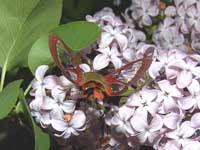 |
Hemaris gracilis
WO, Slender Clearwing, Graceful Clearwing:
These moths are diurnal and are most often seen nectaring during the day at flowers. Note the smooth inner edge of the burgundy forewing outer margin and the
reddish upper surface of the legs.
|
 |
Hemaris thysbe WO/JFR, Hummingbird Clearwing:
This interesting day flier is now confirmed for Taylor, courtesy of Joan F. Rickert. They are widely distributed in the east from P.E.I. to Florida.
|
Hemaris thysbe, June 1, 2006, June 13, 2008, Joan F. Rickert
Philampelini Tribe:
 |
Eumorpha achemon WO, Achemon Sphinx:
Note the differences between this moth and the Pandorus Sphinx. unlikely, further south in Wisconsin
|
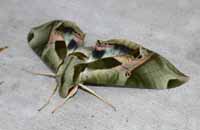 |
Eumorpha pandorus WO, Pandorus Sphinx:
If you have Grape or Virginia Creeper nearby, then you probably have
pandorus. I often get asked to identify larvae from areas where they have not previously been reported. unlikely, further south in Wisconsin
|
Macroglossini Tribe:
 |
Amphion floridensis JFR/WO, Nessus Sphinix:
This day flier is widely distributed. If you have Virginia Creeper,
you probably have the Nessus Sphinx. Two bright, distinct, narrow
yellow bands are often visible on the abdomen.
|
Ampohion floridensis, Medford, May 31, 2008, May 27, 2012, courtesy of Joan F. Rickert.
 |
Darapsa choerilus WO, Azalea Sphinx:
You will often see this species listed as Darapsa pholus, especially in older literature.
|
 | Darapsa myron WO,
Virginia Creeper Sphinx, Grapevine Sphinx:
Dark brown to pale yellowish gray, with an olive tint, often more green than described.
On costal margin there is dark rectangular patch, may be reduced or absent.
Hw: pale orange.
|
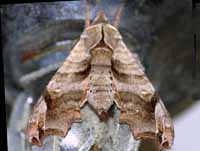 |
This species has not been recorded in Taylor.
It is seen in southern Ontario, however, and in central and
southern Wisconsin. unlikely, further south in Wisconsin
|
 |
Hyles gallii
WO, the Bedstraw Hawk Moth
or Gallium Sphinx
This species is not reported in Taylor, but it has been recorded in
eastern Wisconsin counties. I suspect it is present.
Some years I see them on P.E.I., some years, I do not.
|
 |
Hyles lineata
JFR/WO, the White-lined Sphinx
Adults usually fly at dusk, during the night, and at dawn, but they
also fly during the day over a wide variety of open habitats
including deserts, suburbs, and gardens.
|
Hyles lineata adult: May 31, 2007; June 1, 2012; larva July 10, 2009 and July 14, 2010; Medford, Joan F. Rickert
 |
This moth is very much under reported on USGS. It is a
rapid day flier so is probably not in too many collections.
Grape is a popular larval host.
|
|
|



